Simulation of Temperature Field in Micro-EDM Assisted Machining of Micro-Holes in Printed Circuit Boards
Abstract
:1. Introduction
2. Simulation Model
2.1. Assumptions of Simulation Conditions
2.2. Establishment of Heat Transfer Model
2.3. Simulation Conditions
3. Results and Discussion
3.1. Simulation of the Temperature Field of the Micro-bit
3.2. Effects of Machining Voltages on the Temperature Field of the Micro-bit
3.3. Effects of Pulse Widths on the Temperature Field of the Micro-bit
3.4. Effects of Spindle Speed on the Temperature Field of the Micro-bit
4. Model Verification
4.1. Experimental Design
4.2. Experimental Results
5. Conclusions
Author Contributions
Funding
Data Availability Statement
Conflicts of Interest
References
- Foroutan, M.; Naeini, V.F.; Ebrahimi, M. Carbon nanotubes encapsulating fullerene as water nano-channels with distinctive selectivity: Molecular dynamics simulation. Appl. Surf. Sci. 2019, 489, 198–209. [Google Scholar] [CrossRef]
- Feng, X.; Xu, B.; Lei, J.; Wu, X.; Fu, L. Elimination of Hole Mouth Burr in Multilayer PCB Micro-Hole by Using Micro-EDM. Micromachines 2021, 12, 688. [Google Scholar] [CrossRef] [PubMed]
- Tanjilul, M.; Keong, D.N.W.; Kumar, A.S. Super Dielectric Based EDM Process for Drilling of Inconel 718. Mater. Manuf. Processes 2020, 36, 341–350. [Google Scholar] [CrossRef]
- Shin, M.-C.; Kim, Y.-S.; Cheong, H.-G.; Chu, C.-N. Performance of a TR-iso-pulse generator in micro ED-drilling. Precis. Eng. 2019, 56, 438–446. [Google Scholar] [CrossRef]
- Singh, R.; Dvivedi, A.; Kumar, P. EDM of high aspect ratio micro-holes on Ti-6Al-4V alloy by synchronizing energy interactions. Mater. Manuf. Processes 2020, 35, 1188–1203. [Google Scholar] [CrossRef]
- Kumar, K.; Singh, V.; Katyal, P.; Sharma, N. EDM μ-drilling in Ti-6Al-7Nb: Experimental investigation and optimization using NSGA-II. Int. J. Adv. Manuf. Technol. 2019, 104, 2727–2738. [Google Scholar] [CrossRef]
- Liang, W.; Singh, V.; Katyal, P.; Sharma, N. Tool electrode wear compensation in block divided EDM process for improving accuracy of diffuser shaped film cooling holes. Int. J. Adv. Manuf. Technol. 2019, 103, 1759–1767. [Google Scholar] [CrossRef]
- Tang, J.; Yang, X. Simulation investigation of thermal phase transformation and residual stress in single pulse EDM of Ti–6Al–4 V. J. Phys. D Appl. Phys. 2018, 51, 135308. [Google Scholar] [CrossRef]
- Yang, F.; Jun, Q.; Wang, J.; Dominiek, R. Simulation and experimental analysis of alternating-current phenomenon in micro-EDM with a RC-type generator. J. Mater. Process. Technol. 2018, 255, 865–875. [Google Scholar] [CrossRef]
- Choubey, M.; Maity, K.P.; Sharma, A. Finite element modeling of material removal rate in micro-EDM process with and without ultrasonic vibration. Grey Syst. Theory Appl. 2020, 10, 311–319. [Google Scholar] [CrossRef]
- Ablyaz, T.R.; Shlykov, E.S.; Muratov, K.R.; Sidhu, S.S. Analysis of Wire-Cut Electro Discharge Machining of Polymer Composite Materials. Micromachines 2021, 12, 571. [Google Scholar] [CrossRef] [PubMed]
- Li, Z.; Tang, J.; Bai, J. A novel micro-EDM method to improve microhole machining performances using ultrasonic circular vibration (UCV) electrode. Int. J. Mech. Sci. 2020, 175, 105574. [Google Scholar] [CrossRef]
- Heo, S.; Jeong, Y.H.; Min, B.K.; Lee, S.J. Virtual EDM simulator: Three-dimensional geometric simulation of micro-EDM milling processes. Int. J. Mach. Tools Manuf. 2009, 49, 1029–1034. [Google Scholar] [CrossRef]
- Somashekhar, K.P.; Mathew, J.; Ramachandran, N. Electrothermal theory approach for numerical approximation of the μ-EDM process. Int. J. Adv. Manuf. Technol. 2012, 61, 1241–1246. [Google Scholar] [CrossRef]
- Quarto, M.; D’Urso, G.; Giardini, C.; Maccarini, G. FEM model development for the simulation of a micro-drilling EDM process. Int. J. Adv. Manuf. Technol. 2020, 106, 3095–3104. [Google Scholar] [CrossRef]
- Nadda, R.; Nirala, C.K. Thermal modeling of single discharge in prospect of tool wear compensation in μEDM. Int. J. Adv. Manuf. Technol. 2020, 107, 4573–4595. [Google Scholar] [CrossRef]
- Yue, X.; Yang, X. Molecular dynamics simulation of material removal process and mechanism of EDM using a two-temperature model. Appl. Surf. Sci. 2020, 528, 147009. [Google Scholar] [CrossRef]
- Tang, L.; Ji, Y.; Ren, L.; Zhai, K.G.; Huang, T.Q.; Fan, Q.M.; Zhang, J.J.; Liu, J. Thermo-electrical coupling simulation of powder mixed EDM SiC/Al functionally graded materials. Int. J. Adv. Manuf. Technol. 2019, 105, 2615–2628. [Google Scholar] [CrossRef]
- Ikai, T.; Hashigushi, K. Heat Input for Crater Formation in EDM. Proc. Int. Symp. Electro Mach. ISEMKI 1995, 66, 4104–4111. [Google Scholar]
- Wang, K.; Zhang, Q.; Zhu, G.; Liu, Q.; Huang, Y.; Zhang, J. Research on the energy distribution of micro EDM by utilization of electro-thermal model. Int. J. Adv. Manuf. Technol. 2017, 93, 4179–4186. [Google Scholar] [CrossRef]
- Xu, B.; Feng, X.K.; Wu, X.Y.; Luo, F.; Fu, L.Y.; Zhai, X.T.; Lei, J.G. Micro-EDM-assisted machining micro-holes in printed circuit board. Int. J. Adv. Manuf. Technol. 2021, 113, 1191–1201. [Google Scholar] [CrossRef]

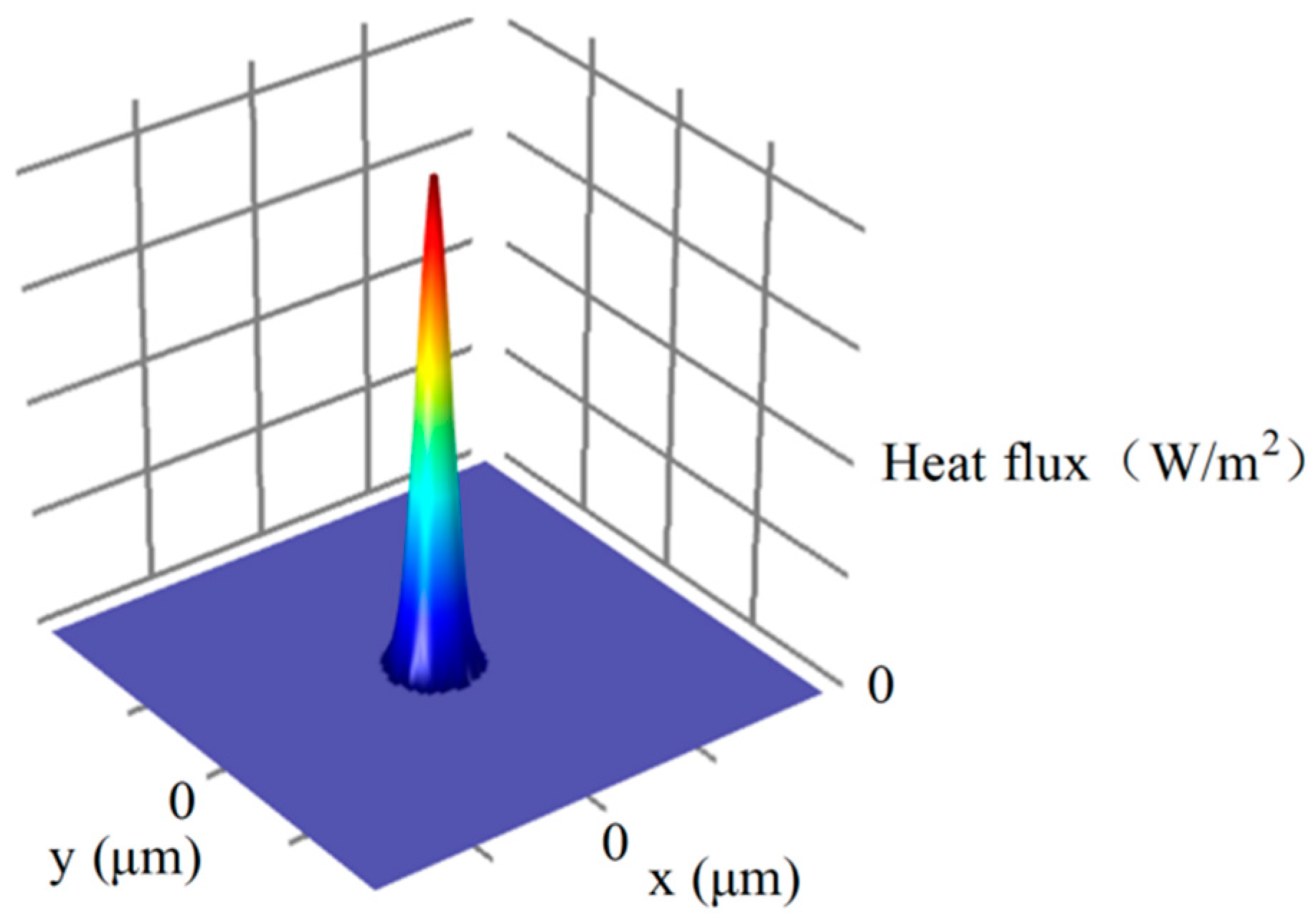
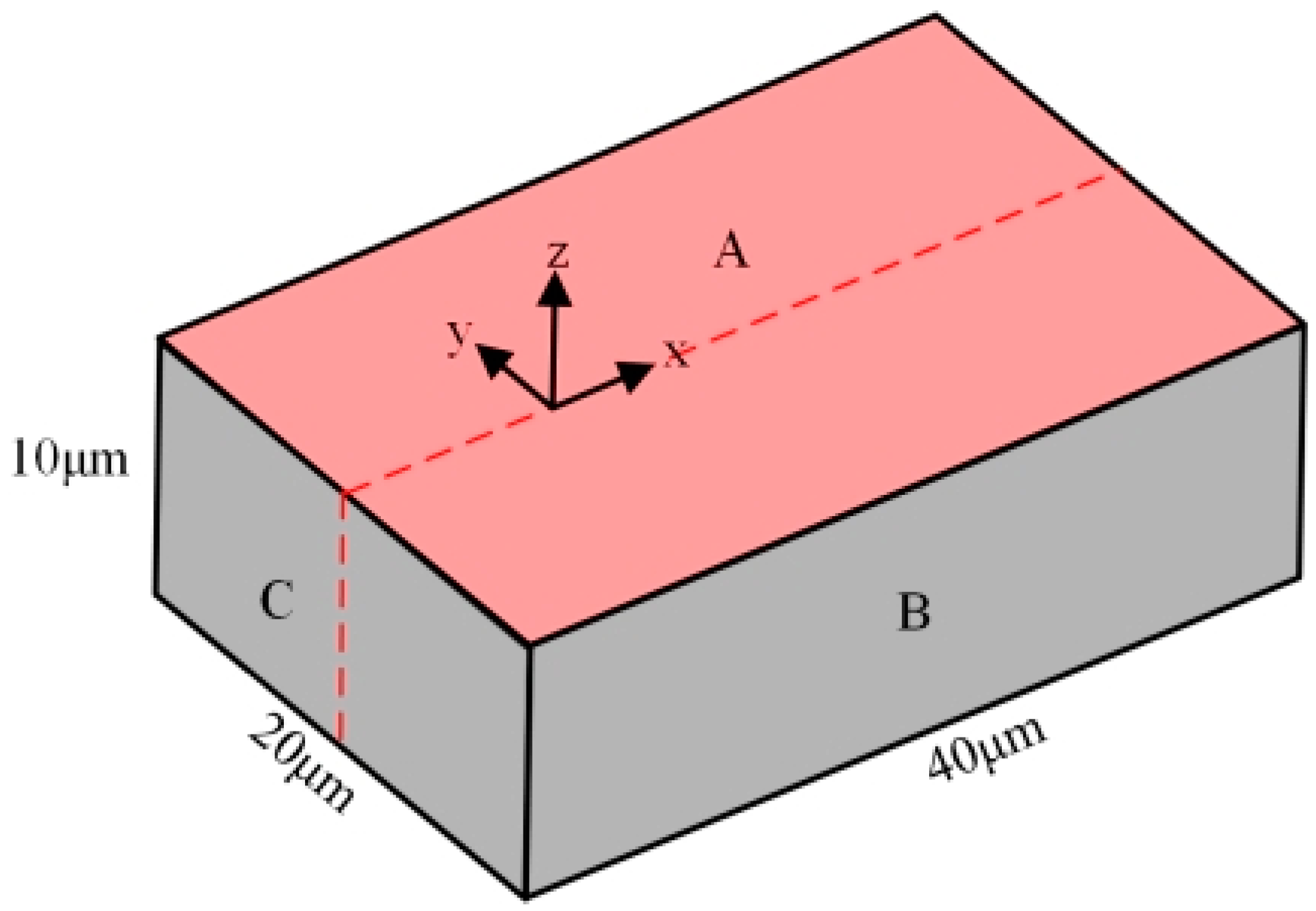


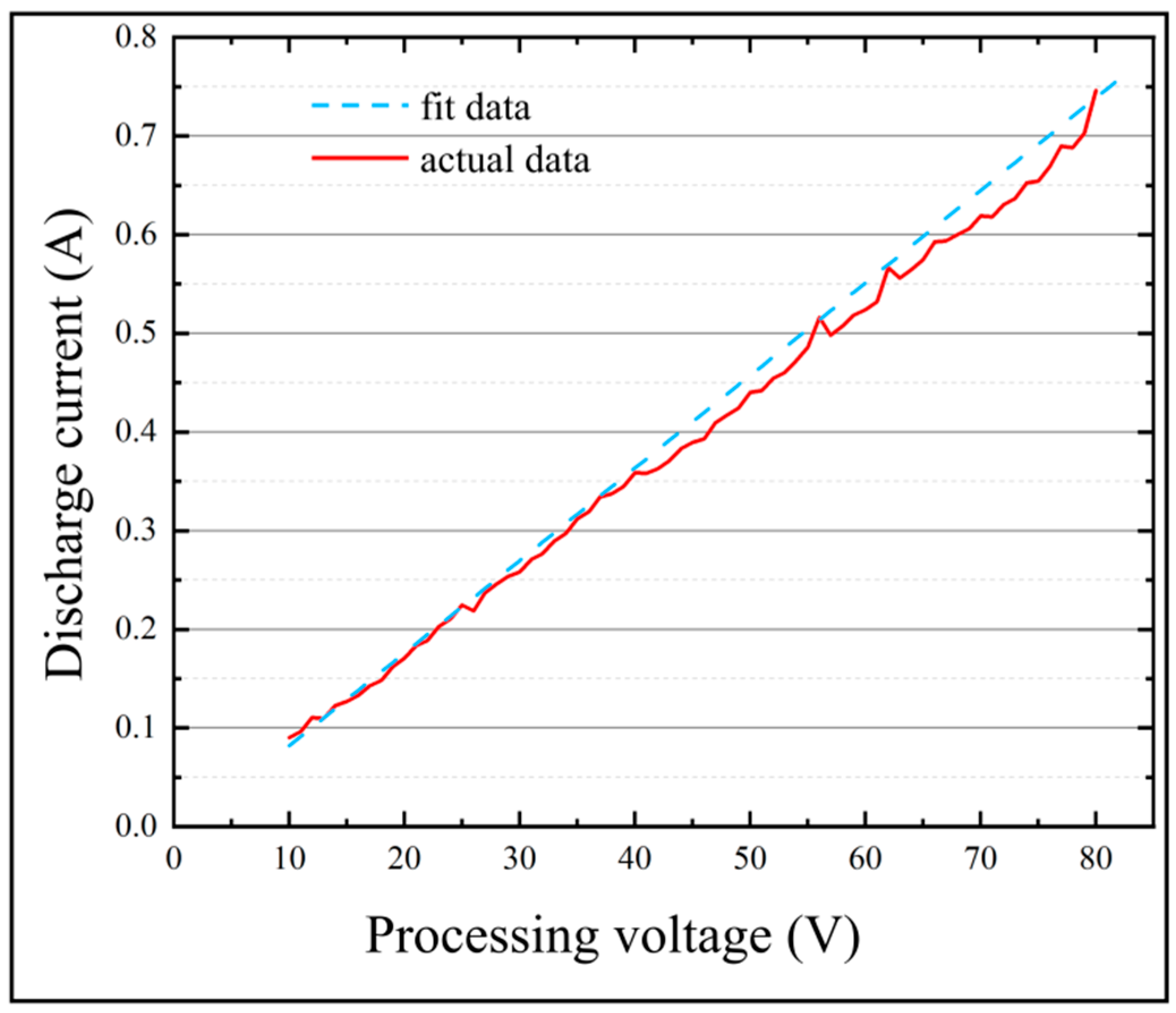
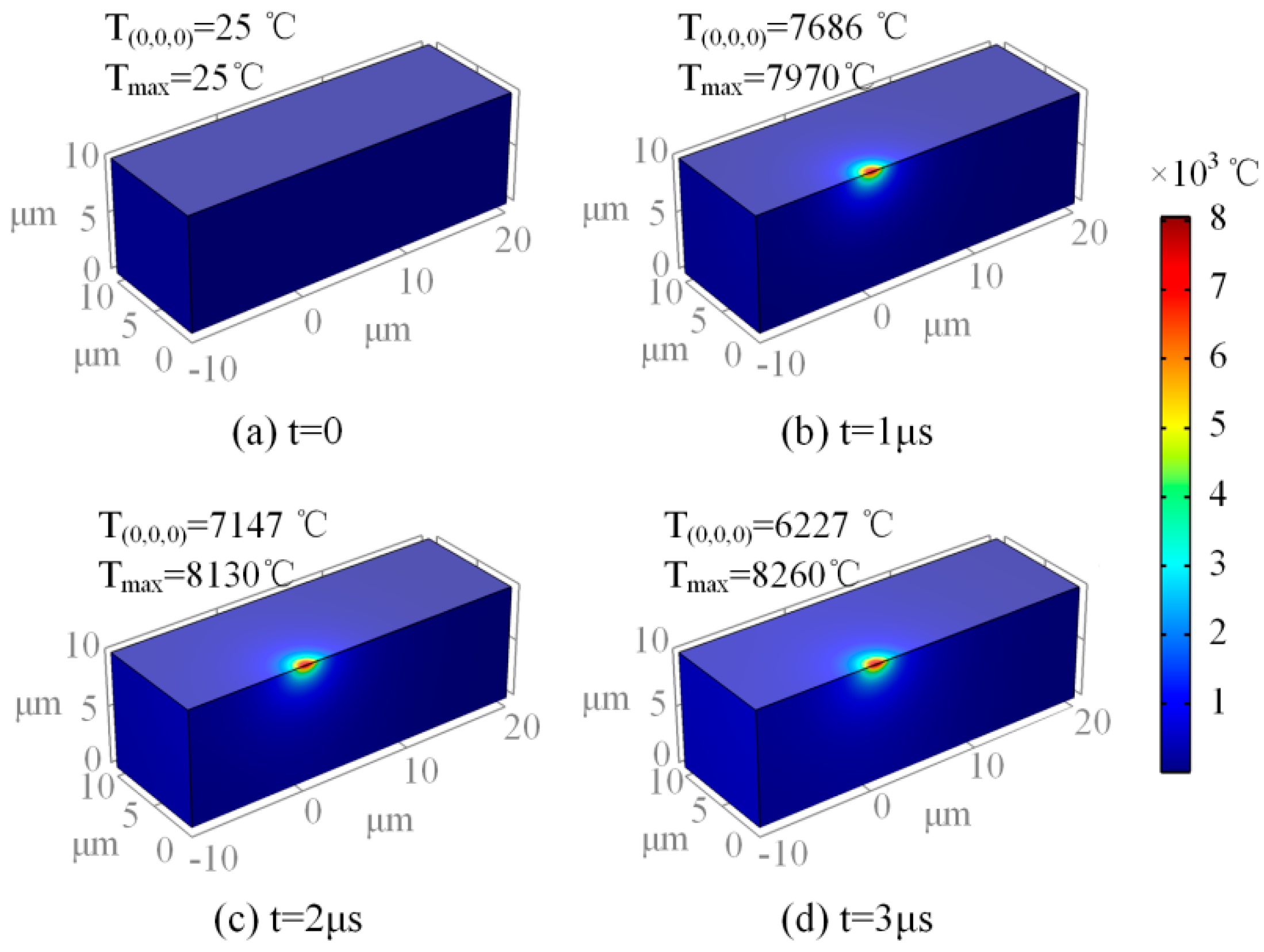
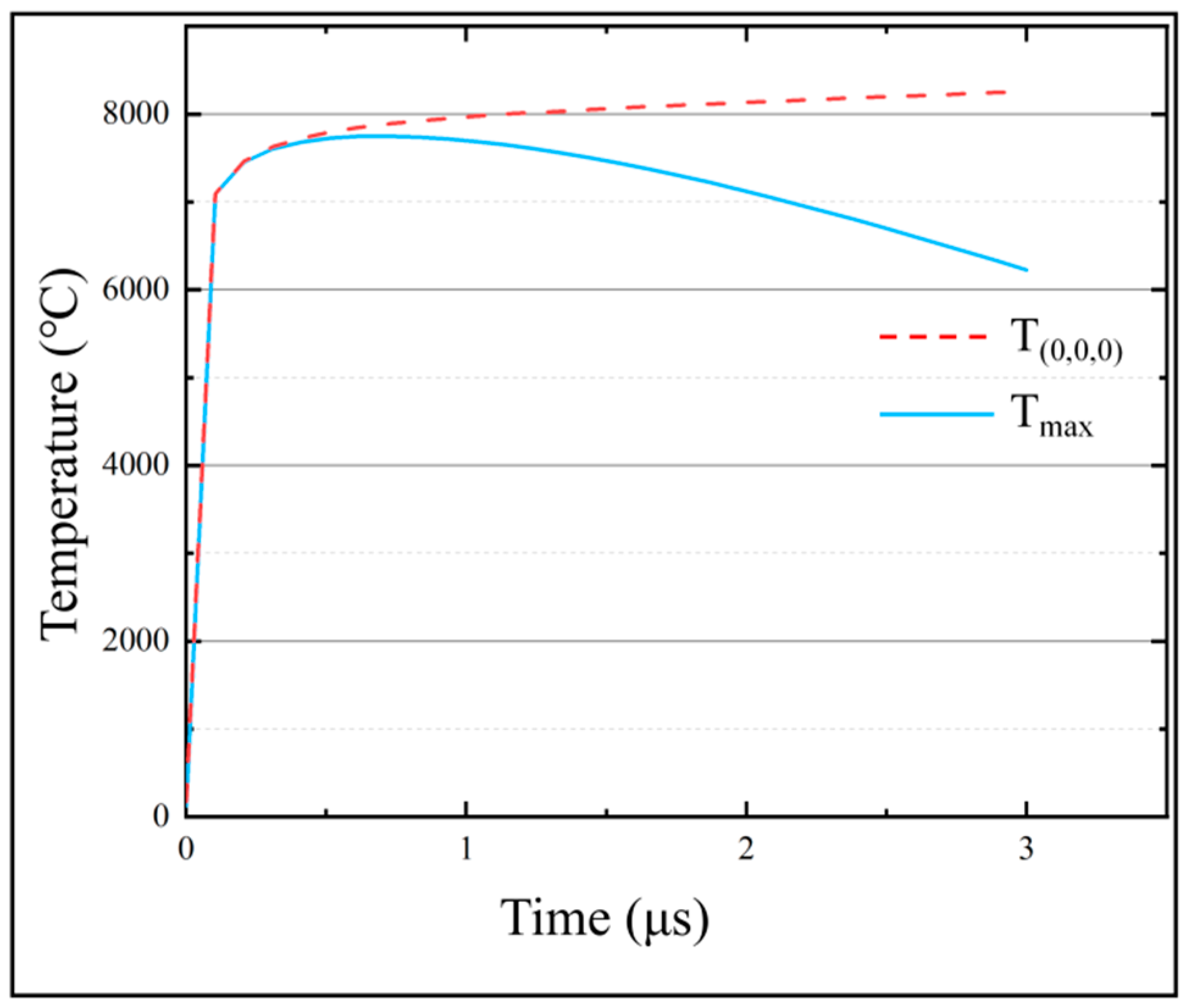

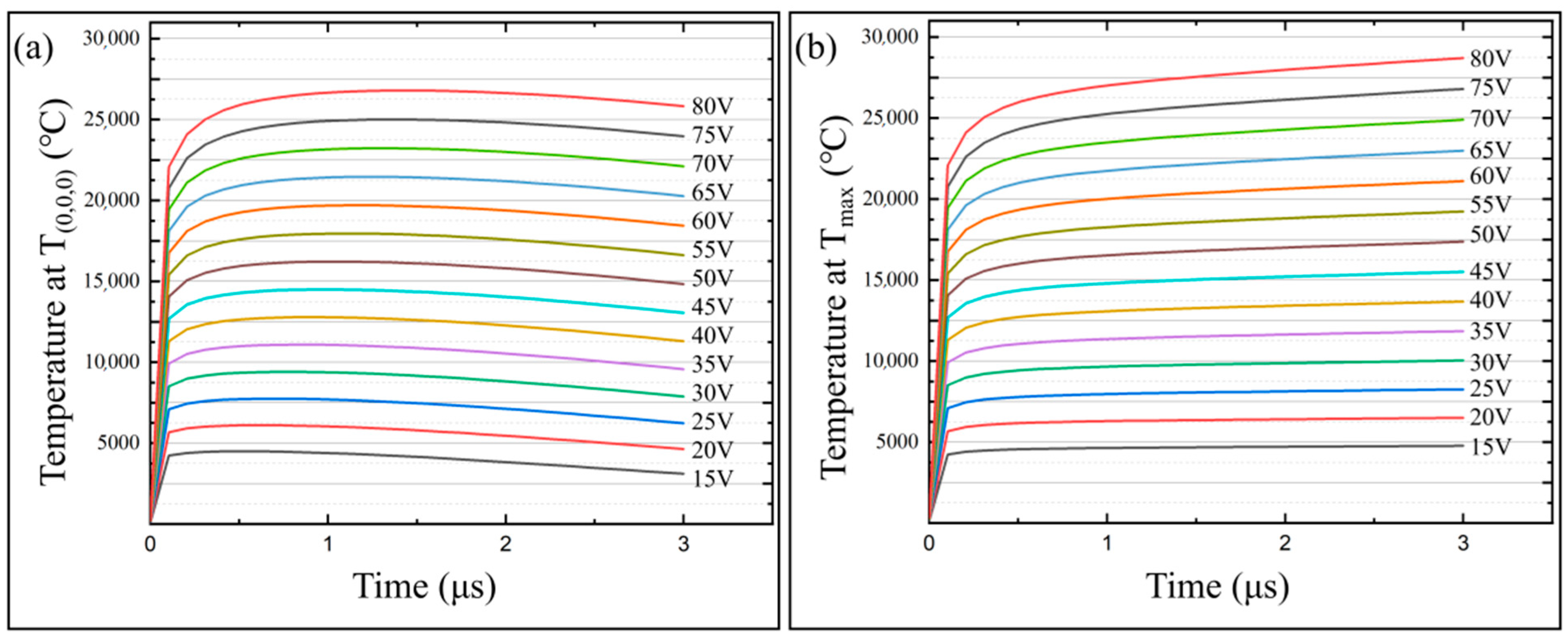
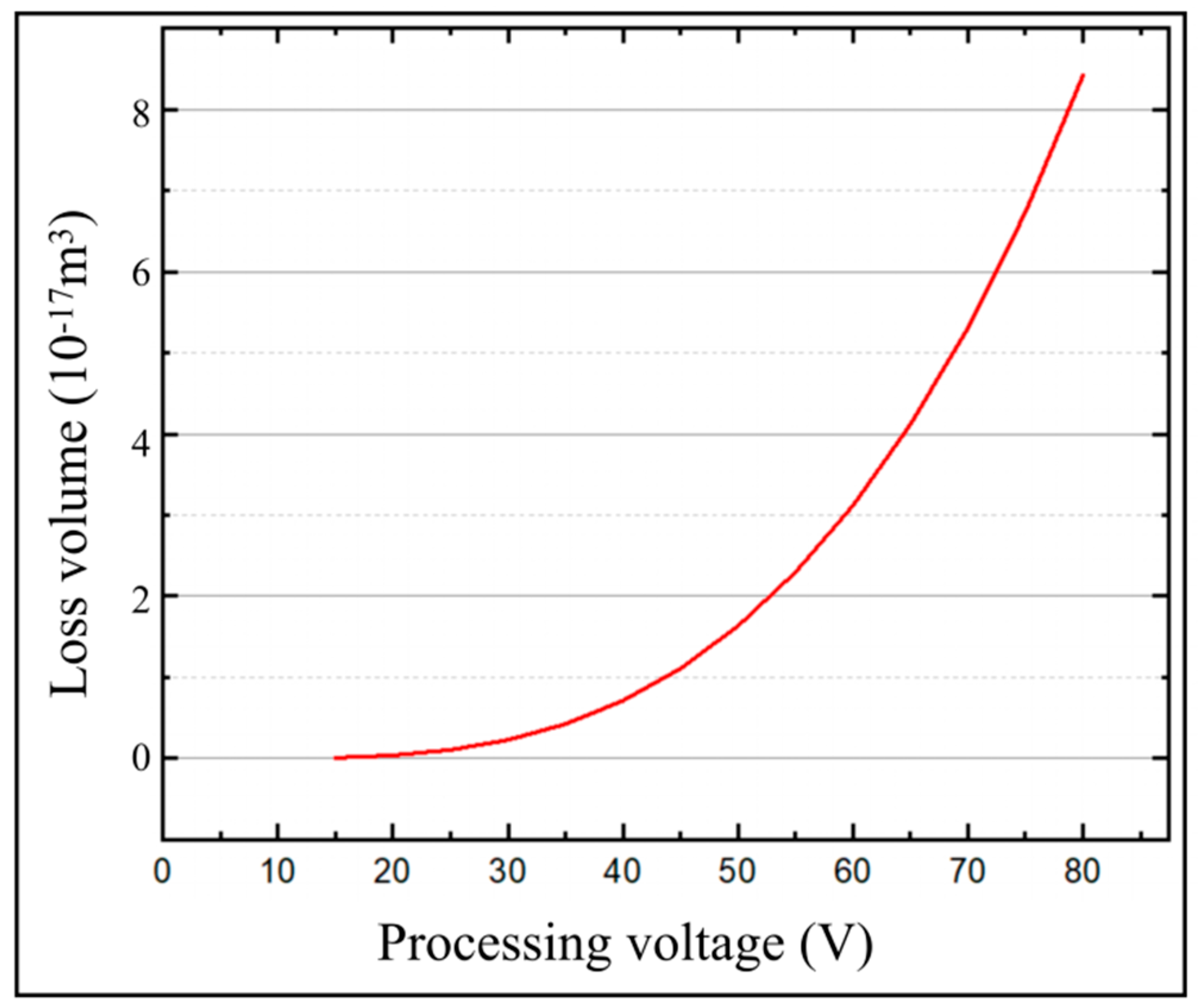
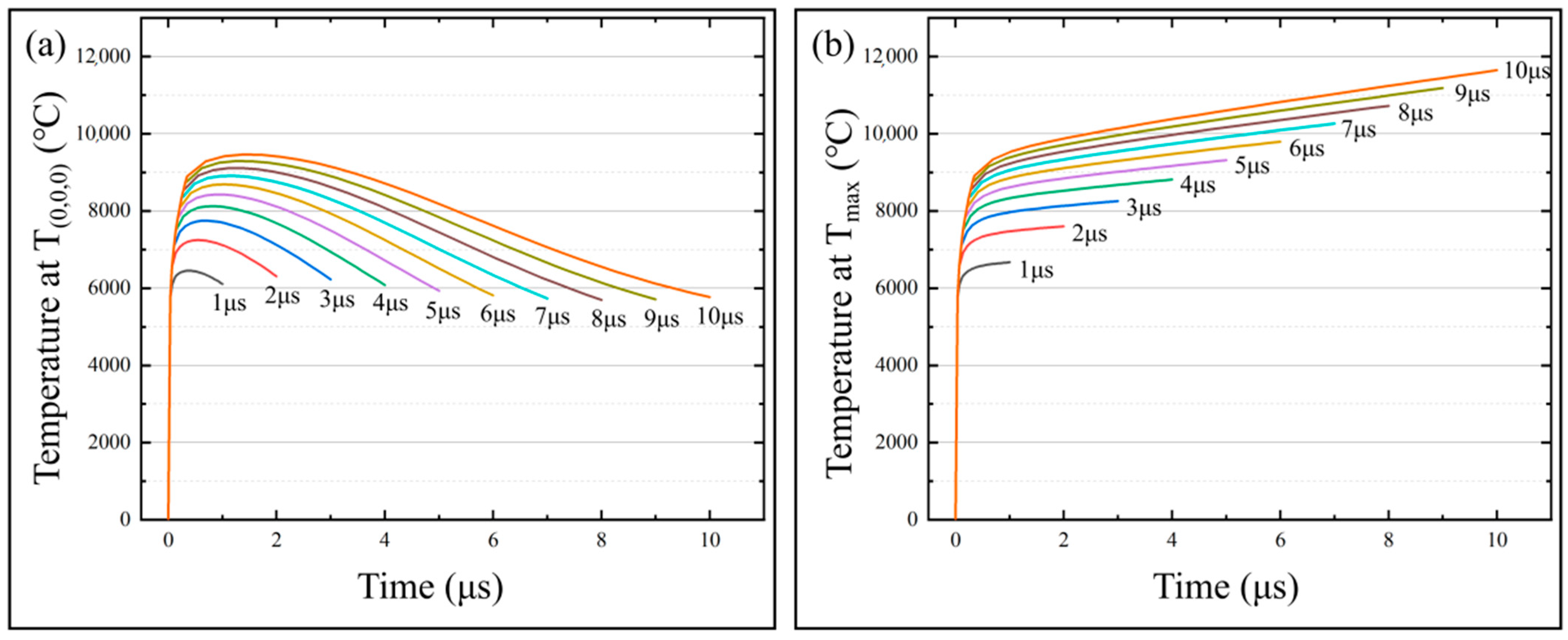
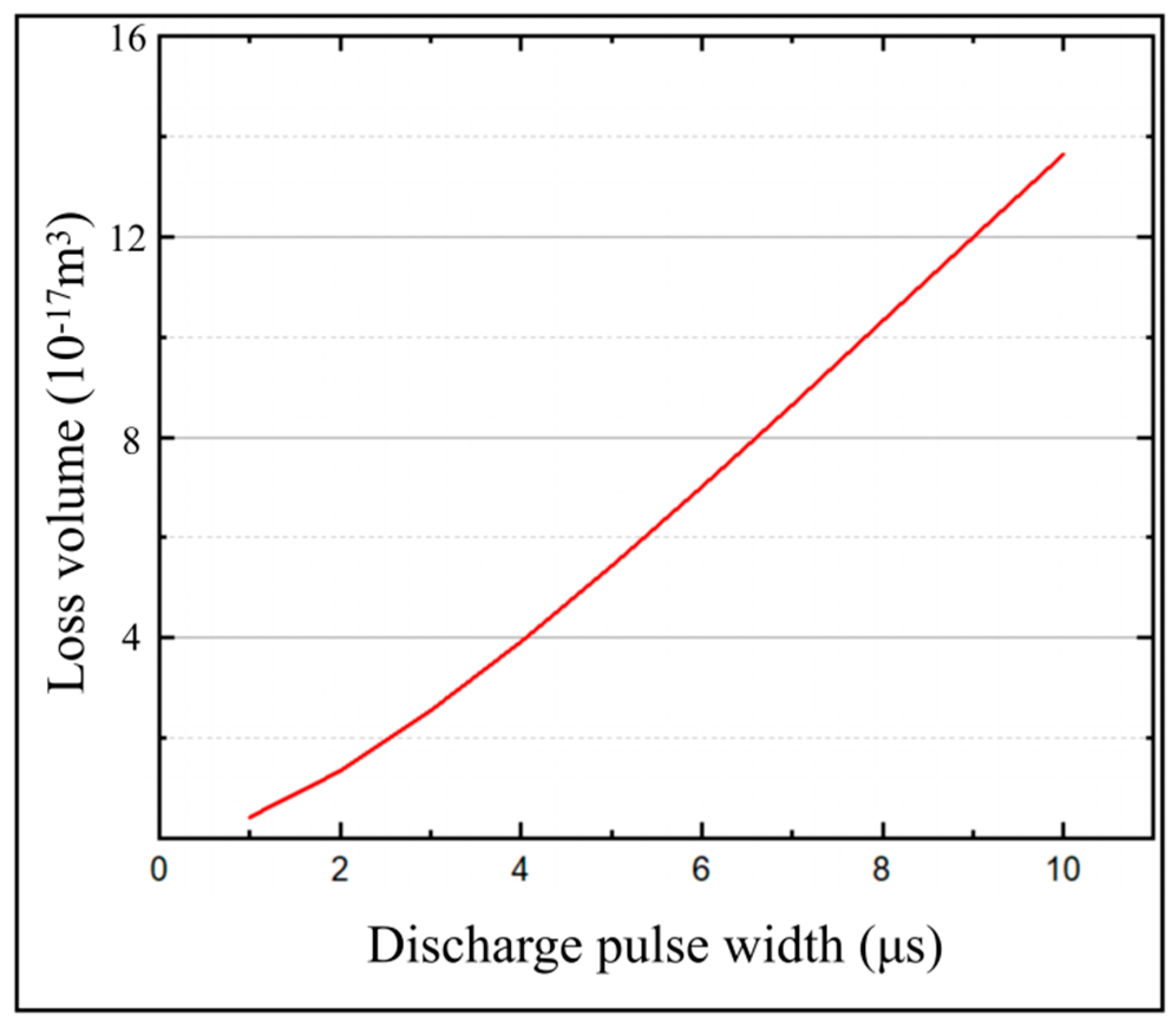
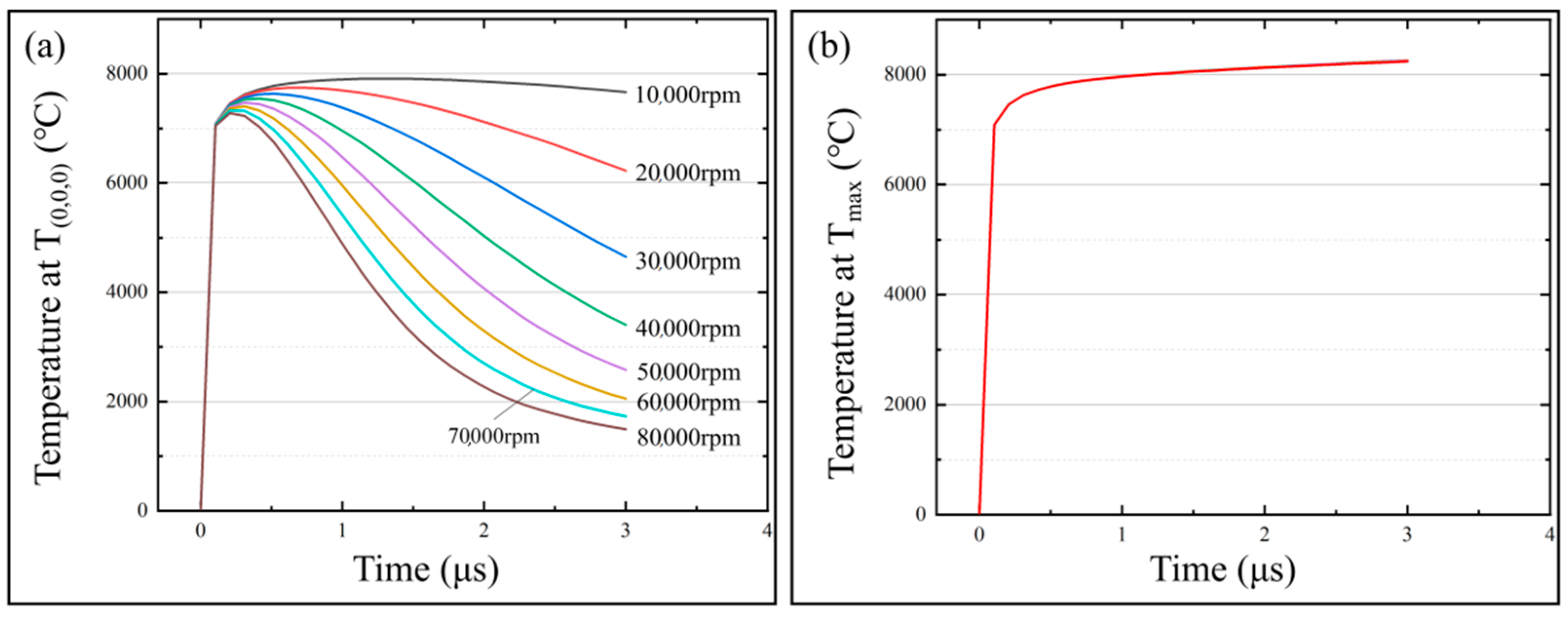
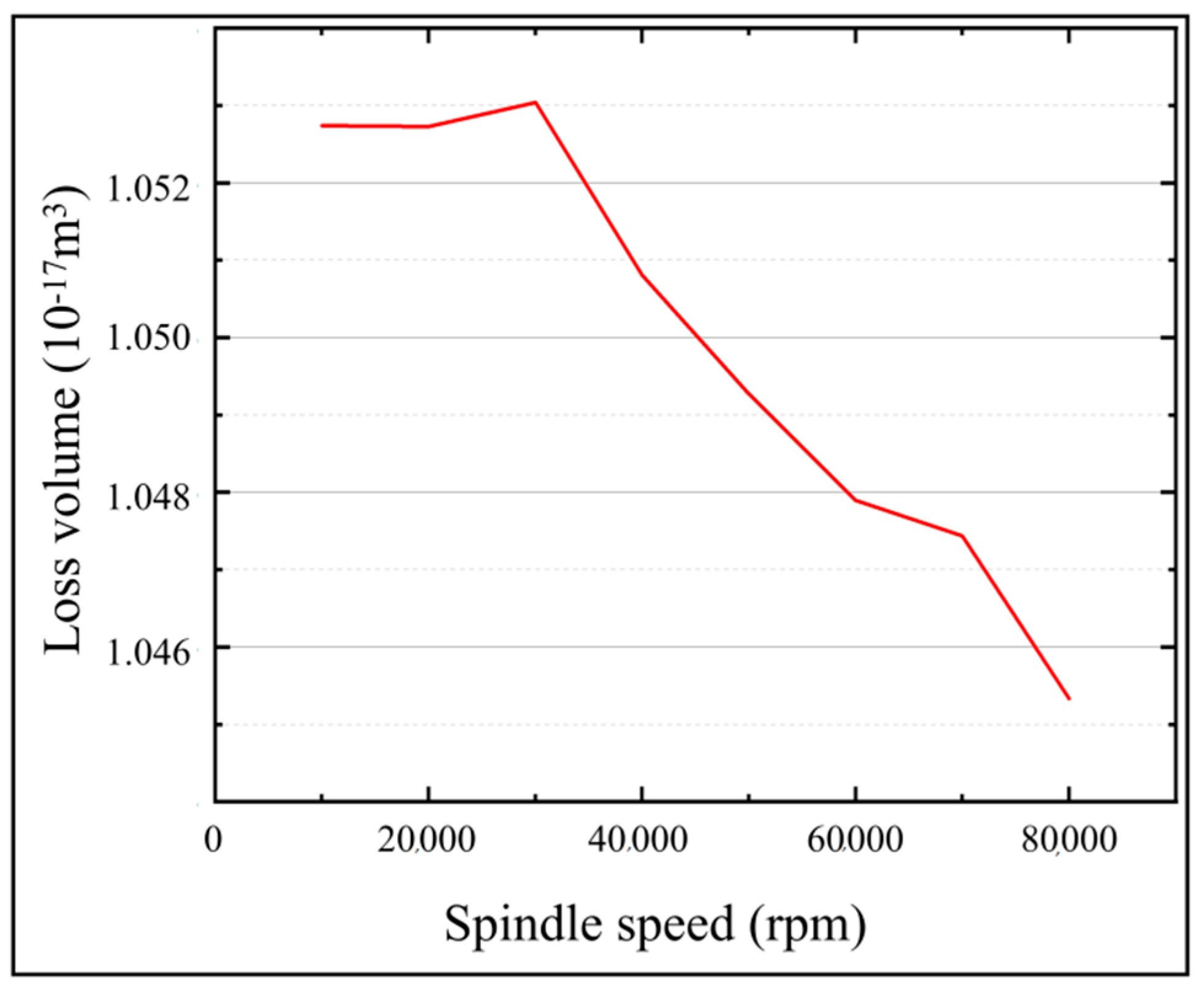
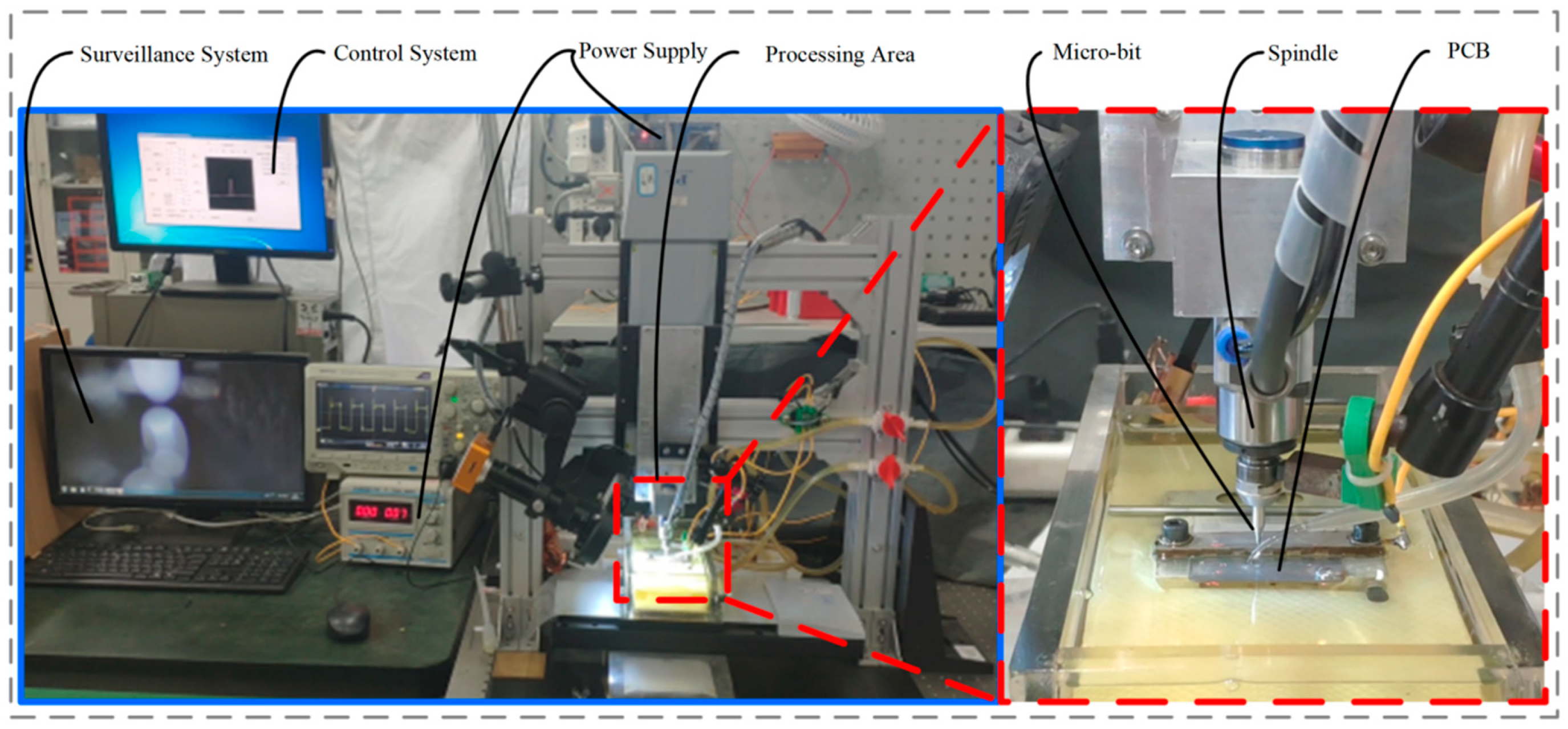
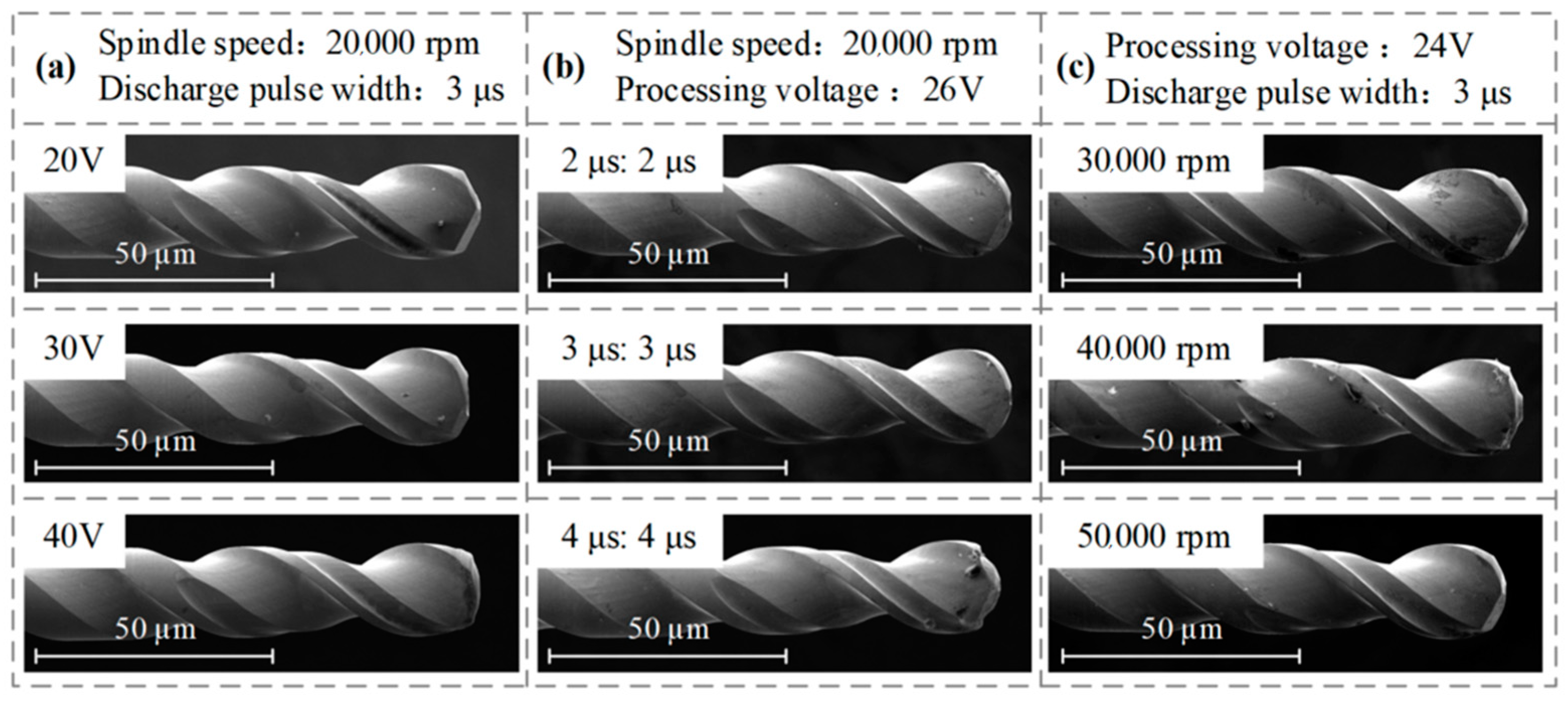
| Material Properties | Value |
|---|---|
| Density | 14,500 kg/m3 |
| Constant pressure heat capacity | 209 J/(kg*K) |
| Thermal Conductivity | 75.36 W/(m*K) |
| Melting point | 2800 °C |
| Thermal expansion coefficient | 4.5 × 10−6/°C |
| Hardness | 89.5 HRA |
| Processing Voltage/V | Discharge Current/A | Processing Voltage/V | Discharge Current/A | Processing Voltage/V | Discharge Current/A | Processing Voltage/V | Discharge Current/A |
|---|---|---|---|---|---|---|---|
| 10 | 0.090416 | 28 | 0.245740 | 46 | 0.393160 | 64 | 0.564680 |
| 11 | 0.096498 | 29 | 0.253440 | 47 | 0.409180 | 65 | 0.574560 |
| 12 | 0.110806 | 30 | 0.257980 | 48 | 0.417060 | 66 | 0.592720 |
| 13 | 0.109786 | 31 | 0.270880 | 49 | 0.424460 | 67 | 0.593780 |
| 14 | 0.122738 | 32 | 0.276700 | 50 | 0.440360 | 68 | 0.599980 |
| 15 | 0.126736 | 33 | 0.289440 | 51 | 0.442040 | 69 | 0.606080 |
| 16 | 0.133314 | 34 | 0.297040 | 52 | 0.454180 | 70 | 0.619160 |
| 17 | 0.142644 | 35 | 0.311840 | 53 | 0.460180 | 71 | 0.617940 |
| 18 | 0.148212 | 36 | 0.319100 | 54 | 0.472200 | 72 | 0.630120 |
| 19 | 0.162370 | 37 | 0.334100 | 55 | 0.486100 | 73 | 0.636820 |
| 20 | 0.170902 | 38 | 0.337540 | 56 | 0.516160 | 74 | 0.652580 |
| 21 | 0.183612 | 39 | 0.344600 | 57 | 0.497940 | 75 | 0.654200 |
| 22 | 0.188642 | 40 | 0.358600 | 58 | 0.507000 | 76 | 0.669060 |
| 23 | 0.202720 | 41 | 0.358280 | 59 | 0.518600 | 77 | 0.689520 |
| 24 | 0.210520 | 42 | 0.362780 | 60 | 0.523720 | 78 | 0.688400 |
| 25 | 0.224880 | 43 | 0.370780 | 61 | 0.531900 | 79 | 0.702660 |
| 26 | 0.218660 | 44 | 0.383220 | 62 | 0.566640 | 80 | 0.746360 |
| 27 | 0.236940 | 45 | 0.389480 | 63 | 0.556040 | 81 | 0.74931 |
Publisher’s Note: MDPI stays neutral with regard to jurisdictional claims in published maps and institutional affiliations. |
© 2022 by the authors. Licensee MDPI, Basel, Switzerland. This article is an open access article distributed under the terms and conditions of the Creative Commons Attribution (CC BY) license (https://creativecommons.org/licenses/by/4.0/).
Share and Cite
Lian, M.; Feng, X.; Xu, B.; Fu, L.; Jiang, K. Simulation of Temperature Field in Micro-EDM Assisted Machining of Micro-Holes in Printed Circuit Boards. Micromachines 2022, 13, 776. https://doi.org/10.3390/mi13050776
Lian M, Feng X, Xu B, Fu L, Jiang K. Simulation of Temperature Field in Micro-EDM Assisted Machining of Micro-Holes in Printed Circuit Boards. Micromachines. 2022; 13(5):776. https://doi.org/10.3390/mi13050776
Chicago/Turabian StyleLian, Manqun, Xinke Feng, Bin Xu, Lianyu Fu, and Kai Jiang. 2022. "Simulation of Temperature Field in Micro-EDM Assisted Machining of Micro-Holes in Printed Circuit Boards" Micromachines 13, no. 5: 776. https://doi.org/10.3390/mi13050776





